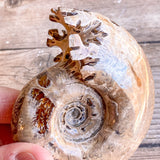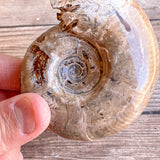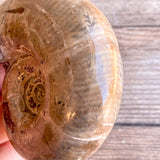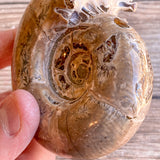Fossil Specimen
This authentic Ammonite has had its end chamber hollowed out so you can see a different view of the sutured septa, which are the curly lines that look like a leaf pattern. It has also been polished on the outside so you can see each stunning sutured pattern that encompasses this entire fossil specimen. This ammonite fossil is from Madagascar. CG303
Approximately 3.25" length x 1.45" width x 2.7" height.
Weight: 7.9 oz. (224 grams).
History of Ammonites
There were many different types of ammonites dating between the Jurassic and Devonian periods (65 and 419 million years ago). The more complex the ammonite fossils, the more recently they were created in those periods. Ammonites died away at the same time as the dinosaurs.
Ammonites (subclass Ammonoidea) can be distinguished by their septa, the dividing walls that separate the chambers and are a group of extinct marine mollusc animals in the subclass Ammonoidea of the class Cephalopada. These molluscs are more closely related to living coleoids such as octopuses, squid, and cuttlefish.





















